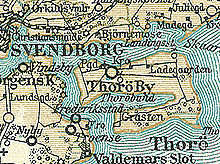Electric ferry Thurø
The Electric Ferry Thurø was a trolley ferry that connected the Danish city of Svendborg on Fyn with the island of Thurø .
history
As Thurø is only a few kilometers from Svendborg, the island is a popular residential area. The island is Denmark's second most densely populated island after Amager .
People used to be carried across Skårupøre Sund in small rowing boats , while cows and horses had to swim across the inlet. Steam boats and later motor boats replaced the rowing boats in the late 1800s and from around 1900 the animals could be transported with these.
A ferry service was opened in the late 1890s. It was bought by master bricklayer Jørgen Larsen from Thurø, who made the ferry crossing between Nørreodde on Thurø and Bjørnemoseløkken on Fyn from 1908 using a wooden frame as a cable ferry that had a hand winch through which a chain lying on the seabed was guided. Short dams have been built into Skårupøre Sund on both banks from the north and south so that the ferry does not have to cross the entire width of the sound .
Due to the increasing traffic, the ferry traffic became complex and so in 1911 the ferry operation was switched to electrical operation, whereby the hand winch was replaced by an electric motor. On the shore of the island of Fyn there was a bell device with which the ferry could be called when it was in Thurø. The power supply was similar to that of a tram with an overhead line that was supported on each of the two pier heads with a support mast.
Larsen also built the ferry house ( Færgegården ) on the island of Thurø in 1919 , which he lived in until the ferry was closed. The ferry house and the two pier heads are still there.
Thurøfærgen
For the ferry service, the Jens Nielsen shipyard in Thurø built a new boat with the construction number 6/1908, which was driven with a hand winch until 1911 and then with an electric motor. It had a load capacity of over 1,700 kg.
The whereabouts of the ferry after the line was closed is unknown.
Replacement of the ferry
The first plans for a permanent connection to replace the ferry were made in 1931 when Jørgen Larsen applied for a permit to build a pontoon bridge between the two piers. The pontoon bridge should have been used for this, which was no longer needed there after the construction of the Kong Christian den X's Bro , which opened in 1930 over the Als Sund near Sønderborg .
In 1934 the ferry connection was replaced by a dam connection with a bridge a little further west. This dam was built between 1933 and 1934, with the company H. Hoffmann & Sønner using a lorry from Thurø . There the approximately 500 m long dam was made from around 15,500 m³ of excavated earth. This was transported by trains consisting of four to ten tipping lorries pulled by a steam locomotive . On the Fyn side, this work was only carried out by hand and wheelbarrows.
The construction cost of the bridge was 130,000 crowns , it was opened on February 1, 1934.
Web links
- W. Langes: Ferries from the Danish Islands. Thurøfærgen. In: fjordfaehren.de. Retrieved February 12, 2017 .
Individual evidence
- ↑ Gunner Steenberg: Lidt historie rounds om Thurø. finn-j.dk, accessed on February 12, 2017 (dk).
- ↑ a b Thurø Færgested. (PDF) kulturarvsvendborg.files.wordpress.com, 2011, accessed on February 12, 2017 (dk).
- ↑ a b Thurø færge (Thurø elektriske færge). In: faergelejet.dk. Retrieved on February 12, 2017 (dk).
- ↑ Dansk Fragt- og Banemærkeklub DFBK. Ferry ticket for trucks. In: dfbk.dk/jernbane. Retrieved February 12, 2017 (Danish).
- ↑ Thurøfærgen. tugboatlars.se, accessed February 12, 2017 (Swedish).
- ↑ THURØ-DÆMNINGEN. In: industribaner.dk. Retrieved February 13, 2017 (Danish).
- ↑ a b A. J. Ullidtz: FAST VEJFORBINDELSE FYN-THURØ. (PDF) In: DANSK VEJTIDSSKRIFT. 1934, p. No. 2/143 , accessed on February 13, 2017 (Danish).
Coordinates: 55 ° 3 ′ 21.2 ″ N , 10 ° 39 ′ 19.8 ″ E



